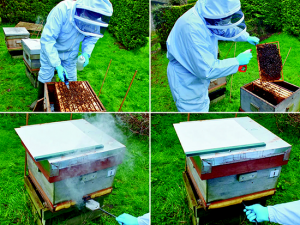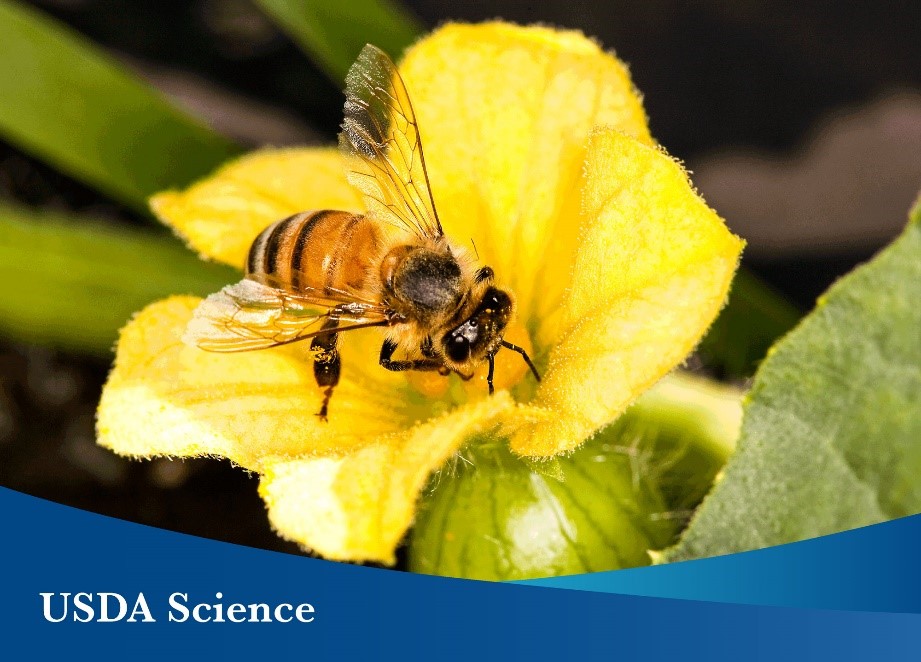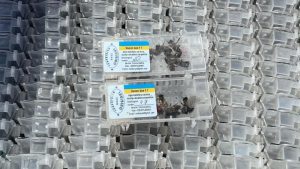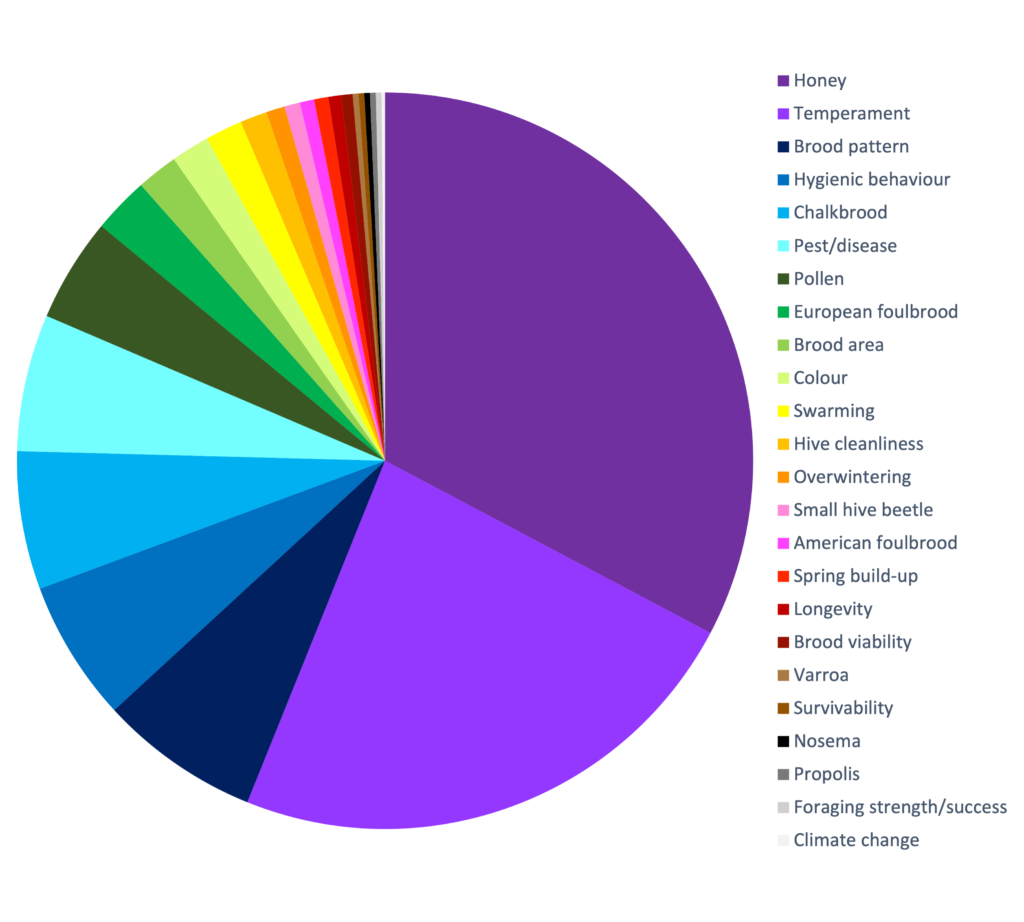By Clarence Collison
OXALIC ACID VARROA TREATMENTS
Standard Oxalic Acid treatments, techniques and results.
Oxalic Acid (OA) is a natural constituent of honey and very effective against the Varroa mite, Varroa destructor (Rashid et al. 2011). Uses of oxalic acid for the control of Varroa have been rapidly increasing in recent years. Three different treatment techniques (i.e. trickling, evaporation or sublimation, and spraying) have been developed and tested for the application of OA against the mite (Rademacher and Harz 2006). Trickling Treatment – Using a syringe or a similar applicator, oxalic acid dehydrate solution is trickled directly onto the bees in the spaces between combs, normally when colonies are in the broodless phase. This application is quick (about one minute per hive), cost effective and easy. Sublimation Treatment – Oxalic acid dehydrate in the form of crystals, gelatin capsules or tablets are heat-evaporated (sublimated) with different types of evaporators, predominantly during the broodless period. This application takes about four minutes per hive and requires complex equipment. Spraying Treatment – Solutions of oxalic acid dehydrate are sprayed onto the bees on both sides of each comb and the bees resting on the hive walls; spraying is normally carried out during the broodless period. This application takes four to five minutes per hive.
Laboratory bioassays were performed to characterize the acute contact toxicity of oxalic acid to Varroa mites and their honey bee hosts. Specifically, glass-vial residual bioassays were conducted to determine the lethal concentration of oxalic acid for the mite, and topical applications of oxalic acid in acetone were conducted to determine the lethal dose for honey bees. The results indicate that oxalic acid has a low acute toxicity to honey bees and a high acute toxicity to mites. The toxicity data will help guide scientists in delivering optimum dosages of oxalic acid to the parasite and its host, and will be useful in making treatment recommendations (Aliano et al. 2006).
Nine divided hives were constructed to study the distribution of oxalic acid. Experimental colonies were split into two equal, queenright sections with one of three divider types. The first divider allowed trophallaxis to occur between adult bees on each side, but did not allow bee-to-contact. The second divider did not allow trophallaxis or bee-to-bee contact. The third divider allowed both bee-to-bee contact and trophallaxis between the two sides. All three dividers allowed gas exchange of volatile materials. The objective was to investigate factors that contribute to the distribution of oxalic acid in a hive by monitoring mite mortality. Forty ml of a 3.5% oxalic acid sugar water solution was trickled on one side of the divider. Sticky boards were used to quantify mite fall before, during, and after OA treatment on both treated and untreated sides. Trophallactic interactions and fumigation did not significantly influence the distribution of oxalic acid. Bee-to-bee contact was the primary route for oxalic acid distribution (Aliano and Ellis 2008).
Three oxalic acid solutions were applied to 24 colonies to test acaricidal effects on the mites. Daily natural mite drop per colony averaged 0.52. Higher mite mortality (18.33) was found after three August OA treatments. The mean efficacy’s of the three water solutions of OA/sucrose (w/w) 3.4%/47.6%, 3.7%/26.1%, and 2.9%/31.9% applied in the presence of brood, was 52.28%, 40.66% and 39.16 %, respectively. A significantly higher efficacy was recorded when 3.4%/47.6%, was applied in comparison to 2.9%/31.9% solution. There was no difference in efficacy between OA solutions administered during a broodless period on October 28. The average efficacy in all colonies was 99.44%. The results suggest that OA has limited acaricidal effect in colonies with brood, but it is highly effective in a broodless period (Gregorc and Planinc 2001).
Twenty-four colonies were used to monitor the efficacy of a solution of 2.9% oxalic acid and 31.9% sugar against Varroa mites. Mite mortality was established prior to and after oxalic treatments, which were conducted in August and September. The treatments resulted in 37% mite mortality as opposed to 1.11% in the controls. Oxalic acid treatment conducted in September on previously untreated colonies resulted in 25% mite mortality.
Oxalic acid treatments in October and November resulted in approximately 97% mite mortality. These results again suggest that oxalic acid is effective during the broodless period and less effective when applied to colonies with capped broods (Gregorc and Planinc 2002).
 The toxicity of various concentrations of oxalic acid dihydrate (OA) in aqueous and sucrose solutions to Varroa mites and to honey bees was assessed using submersion tests of caged bees and by spraying bees in colonies with and without brood (Toomemaa et al. 2010). An aqueous solution of 0.5% OA gave effective control of the mite and was non-toxic to bees whereas higher concentrations of OA (1.0-2.0%) were highly toxic to bees. Submersion tests into solutions with 0.1% OA were acaricidal both in aqueous (59.9 %) and in 50% sucrose solution (71.1%) whereas concentrations of 0.2-0.5% OA were highly effective; OA in sucrose solution was more toxic to bees than OA in the aqueous solution. Spraying with 0.5% OA solution at a dose of 25 ml per comb in May 2003 and in April 2004 was 99.01-99.42% effective in mite control in Estonian standard one box long beehives with 22 frames (each 414 x 277 mm, area 1000 cm2 per comb side). Most mites fell after the first spraying. In Autumn, spraying test colonies that had little capped brood once or twice with a 0.5% OA solution gave effective mite control (92.94% and 91.84%, respectively) with no noticeable toxicity to bees.
The toxicity of various concentrations of oxalic acid dihydrate (OA) in aqueous and sucrose solutions to Varroa mites and to honey bees was assessed using submersion tests of caged bees and by spraying bees in colonies with and without brood (Toomemaa et al. 2010). An aqueous solution of 0.5% OA gave effective control of the mite and was non-toxic to bees whereas higher concentrations of OA (1.0-2.0%) were highly toxic to bees. Submersion tests into solutions with 0.1% OA were acaricidal both in aqueous (59.9 %) and in 50% sucrose solution (71.1%) whereas concentrations of 0.2-0.5% OA were highly effective; OA in sucrose solution was more toxic to bees than OA in the aqueous solution. Spraying with 0.5% OA solution at a dose of 25 ml per comb in May 2003 and in April 2004 was 99.01-99.42% effective in mite control in Estonian standard one box long beehives with 22 frames (each 414 x 277 mm, area 1000 cm2 per comb side). Most mites fell after the first spraying. In Autumn, spraying test colonies that had little capped brood once or twice with a 0.5% OA solution gave effective mite control (92.94% and 91.84%, respectively) with no noticeable toxicity to bees.
Two oxalic acid treatments were given to five colonies in autumn and five colonies in Spring. In each treatment, colonies were treated every seven days for four weeks with a 3% sprayed oxalic acid. Another five colonies in each season served as controls and were sprayed only with water. Efficacy of OA in autumn was 94% and in spring was 73%. A long-term study of the colonies for three to four months after the last application of oxalic acid showed a statistically significant negative effect of the acid on brood development. In addition, three queens died in the treated colonies (Higes et al. 1999).
“Oxalic Acid has a low acute toxicity to honey bees and a high acute toxicity to mites.”
Rashid et al. (2011) evaluated fall OA treatments in Islamabad, Pakistan. Colonies were divided into four groups of five colonies each. Oxalic acid was applied in sugar syrup with 4.2, 3.2 and 2.1% concentrations. The OA with different concentrations was trickled directly on the adult bees in between two frames using a syringe applied three times on different dates at five day intervals. Average mite efficacy of OA with 3.2, 4.2 and 2.1% was 95, 81 and 46%, respectively. No queens were lost, and there was no adult bee mortality in any of the colonies during the experiment. They concluded that 3.2% OA concentration is very effective in controlling mites and can be used without any side effects during the broodless condition.
The effects of OA administered by the trickling method on brood development of honey bee colonies were evaluated (a) by observing the development of marked cells of young (<3 days old) and old (>3 days old) larvae, and (b) by measuring the area of open brood for several weeks post application. Oxalic acid, dissolved in a 50% sugar solution, with an end concentration of 3% w/v oxalic acid, was applied twice by the trickling method during Summer to 10 colonies. A high percentage of young (12.6% and 9.5%) and old honey bee larvae (10.6% and 5.6%) were removed from their cells after the first and second oxalic acid applications, respectively. The surface of the open brood area was also reduced by 17.5% after the two oxalic acid applications and stayed low for about two months. For the same period of time the open brood area in 10 control colonies increased by 34.5%. The two oxalic acid applications removed 60 ± 12% of Varroa mites adhering to adult honey bees, while the natural fall of mites measured in control colonies (for a period of 40 days) was 32 ± 4%. Combining the detrimental effect on brood development with the low relative effectiveness on Varroa removal, oxalic acid application by the trickling method when open brood is present is not as safe as has been regarded in the past. Consideration needs to be given to the use of different sugar and oxalic acid concentrations in the treatment solution in order to minimize its adverse effects on open honey bee brood (Hatjina and Haristos 2005).
Toufailia et al. (2015) determined the efficacy of the natural chemical oxalic acid in killing phoretic Varroa mites on adult worker bees under field conditions in southern England. They compared three oxalic acid application methods (trickling, spraying and sublimation) at three or four (sublimation) doses, using 110 broodless colonies in early January 2013. Treatment efficacy was assessed by extracting mites from samples of c. 270 worker bees collected immediately before and 10 days after treatment. All three methods could give high Varroa mortality, c. 93-95%, using 2.25 g OA per colony. However, sublimation was superior as it gave higher mortality at lower doses (.56 or 1.125 g per colony; trickling 57% mortality; spraying 86%; sublimation 97%). Sublimation using 2.25 g of OA also resulted in three and 12 times less worker bee mortality in the 10 days after application than either trickling or spraying, respectively, and lower colony mortality four months later in mid Spring. Colonies treated via sublimation also had greater brood area four months later than colonies treated via trickling, spraying or control colonies. A second trial in December 2013 treated 89 broodless colonies with 2.25 g OA via sublimation to confirm the previous results. Varroa mortality was 97.6% and 98% of the colonies survived until Spring. This confirms that applying OA via sublimation in broodless honey bee colonies in Winter is a highly effective way of controlling Varroa mites and causes no harm to the colonies.
Some experiments have shown that a single spray with OA in aqueous or sucrose solution is considerably more effective than trickling (Brødsgaard et al. 1999; Bahreini 2003), indicating that greater wetting of bees increases the effectiveness of the oxalic acid in mite control. Toomemaa et al. (2010) using submersion tests also showed the importance of thorough wetting for good mite control. A lower concentration may be considerably less effective in trickling due to less contact of the solution with the bees and mites.
Honey bee colonies in five apiaries were divided into three groups to test if the concentration or the total amount of oxalic acid applied for Varroa control determines treatment efficacy when trickling OA for Varroa mite control (Fries 2001). The treatment groups were 30 ml sugar solution (1:1 weight: volume), 30 ml 3.2% OA in sugar solution and 60 ml 1.6% OA in sugar solution. The results clearly demonstrate that it is the concentration of oxalic acid that is critical for high mite efficacy, rather than the total amount of oxalic acid used. The results also confirm earlier results from trials under Swedish and Norwegian conditions that 30 ml 3.2% for normal sized colonies can be used for mite control with good results without obvious adverse effects on bee colonies over Winter. Fries (2001) found that trickling a 1.6% oxalic acid solution at a higher dose (60 ml per colony), was 92.2% effective. Although concentrations of <4.6% have been tolerated well by bees in experiments by several researchers, in some experiments colonies have been weakened considerably following a single trickling treatment.
 Rademacher et al. (2017) investigated lethal and sublethal effects of oxalic acid on individually treated honey bees kept in cages under laboratory conditions as well as the distribution in the colony. After oral application, bee mortality occurred at relatively low concentrations (No Observed Adverse Effect Level (NOAEL)) 50 µg/bee; (Lowest Observed Adverse Effect Level (LOAEL)) 75µg/bee compared to the dermal treatment (NOAEL 212.5 µg/bee; LOAEL 250 µg/bee). The dosage used in regular treatment via dermal application (circa 175 µg/bee) is below the LOAEL, referring to mortality derived in the laboratory. However, the treatment with oxalic acid dehydrate caused sublethal effects: this could be demonstrated in an increased responsiveness to water, decreased longevity and a reduction in pH-values in the digestive system and the hemolymph (blood). The shift towards stronger acidity after treatment confirms that damage to the epithelial tissue and organs is likely to be caused by hyperacidity. The distribution of OA within a colony was shown by macro-computed tomography; it is rapid and consistent. The increased density of the individual bee was continuous for at least 14 days after treatment indicating the presence of oxalic acid dehydrate in the hive even long after a treatment.
Rademacher et al. (2017) investigated lethal and sublethal effects of oxalic acid on individually treated honey bees kept in cages under laboratory conditions as well as the distribution in the colony. After oral application, bee mortality occurred at relatively low concentrations (No Observed Adverse Effect Level (NOAEL)) 50 µg/bee; (Lowest Observed Adverse Effect Level (LOAEL)) 75µg/bee compared to the dermal treatment (NOAEL 212.5 µg/bee; LOAEL 250 µg/bee). The dosage used in regular treatment via dermal application (circa 175 µg/bee) is below the LOAEL, referring to mortality derived in the laboratory. However, the treatment with oxalic acid dehydrate caused sublethal effects: this could be demonstrated in an increased responsiveness to water, decreased longevity and a reduction in pH-values in the digestive system and the hemolymph (blood). The shift towards stronger acidity after treatment confirms that damage to the epithelial tissue and organs is likely to be caused by hyperacidity. The distribution of OA within a colony was shown by macro-computed tomography; it is rapid and consistent. The increased density of the individual bee was continuous for at least 14 days after treatment indicating the presence of oxalic acid dehydrate in the hive even long after a treatment.
Numerous studies have investigated using oxalic acid to control Varroa mites in honey bee colonies. In contrast, techniques for treating package bees with oxalic acid have not been investigated. The goal of this study was to develop a protocol for using OA to reduce mite infestation in package bees (Aliano and Ellis 2009). They made 97 mini packages of Varroa-infested adult bees. Each package contained 1,613 ± 18 bees and 92 ± 3 mites, and represented an experimental unit. They prepared a 2.8% solution of OA by mixing 35 g OA with 1liter of sugar water (sugar:water =1:1; w:w). Eight treatments were assigned to the packages based on previous laboratory bioassays that characterized the acute contact toxicity of OA to mites and bees. They administered the treatments by spraying the OA solution directly on the bees through the mesh screen cage using a pressurized air brush and quantified mite and bee mortality over a 10-day period. Their results support applying an optimum volume of 3.0 ml of a 2.8% OA solution per 1,000 bees to packages for effective mite control with minimal adult bee mortality. The outcome of their research provides beekeepers and package bee shippers guidance for using OA to reduce mite populations in package bees.
References
Aliano, N.P. and M.D. Ellis 2008. Bee-to-bee contact drives oxalic acid distribution in honey bee colonies. Apidologie 39: 481-487.
Alino, N.P. and M.D. Ellis 2009. Oxalic acid: a prospective tool for reducing Varroa mite populations in package bees. Exp. Appl. Acarol. 48: 303-309.
Aliano, N.P., M.D. Ellis and B.D. Siegfried 2006. Acute contact toxicity of oxalic acid to Varroa destructor (Acari: Varroidae) and their Apis mellifera (Hymenoptera: Apidae) hosts in laboratory bioassays. J. Econ. Entomol. 99: 1579-1582.
Bahreini, R. 2003. A comparison of two methods of applying oxalic acid for control of Varroa. J. Apic. Res. 42: 82-83.
Brødsgaard, C.J., S.E. Jensen, C.W. Hansen and H. Hansen 1999. Spring treatment with oxalic acid in honeybee colonies as Varroa control. DIAS report, Horticulture 6: 1-16.
Fries, I. 2001. Is the total amount or the concentration of oxalic acid critical for efficacy in Varroa mite control? European Group for Integrated Varroa Control, York, http://www.apis.admin.ch/host/varroa/york.htm
Gregorc, A. and I. Planinc 2001. Acaricidal effect of oxalic acid in honeybee (Apis mellifera) colonies. Apidologie 32: 333-340.
Gregorc, A. and I. Planinc 2002. The control of Varroa destructor using oxalic acid. Vet. J. 163: 306-310.
Hatjina, F. and L. Haristos 2005. Indirect effects of oxalic acid administered by trickling method on honey bee brood. J. Apic. Res. 44: 172-174.
Higes, M., A. Meana, M. Suárez and J. Llorente 1999. Negative long-term effects on bee colonies treated with oxalic acid against Varroa jacobsoni Oud. Apidologie 30: 289-292.
Rademacher, E. and M. Harz 2006. Oxalic acid for the control of Varroosis in honey bee colonies- a review. Apidologie 37: 98-120.
Rademacher, E., M. Harz and S. Schneider 2017. Effects of oxalic acid on Apis mellifera (Hymenoptera: Apidae). Insects 8(3): 84 doi:10.3390/insects8030084
Rashid, M., E.S. Wagchoure, A.U. Mohsin, S. Raja and G. Sarwar 2011. Control of ectoparasitic mite Varroa destructor, in honeybee (Apis mellifera L.) colonies by using different concentrations of oxalic acid. J. Anim. Plant Sci. 22: 72-76.
Toomemaa, K. A.-J. Martin and I.H. Williams 2010. The effect of different concentrations of oxalic acid in aqueous and sucrose solution on Varroa mites and honey bees. Apidologie 41: 643-653.
Toufailia, H.A., L. Scandian and F.L.W. Ratnieks 2015. Towards integrated control of Varroa: 2) comparing application methods and doses of oxalic acid on the mortality of phoretic Varroa destructor mites and their honey bee hosts. J. Apic. Res. 54: 108-120.
Photos courtesy Bee Culture magazine, and Frances L.W. Ratnieks, Luciano Scandian, Hasan Al Toufailia
Clarence Collison is an Emeritus Professor of Entomology and Department Head Emeritus of Entomology and Plant Pathology at Mississippi State University, Mississippi State, MS.










